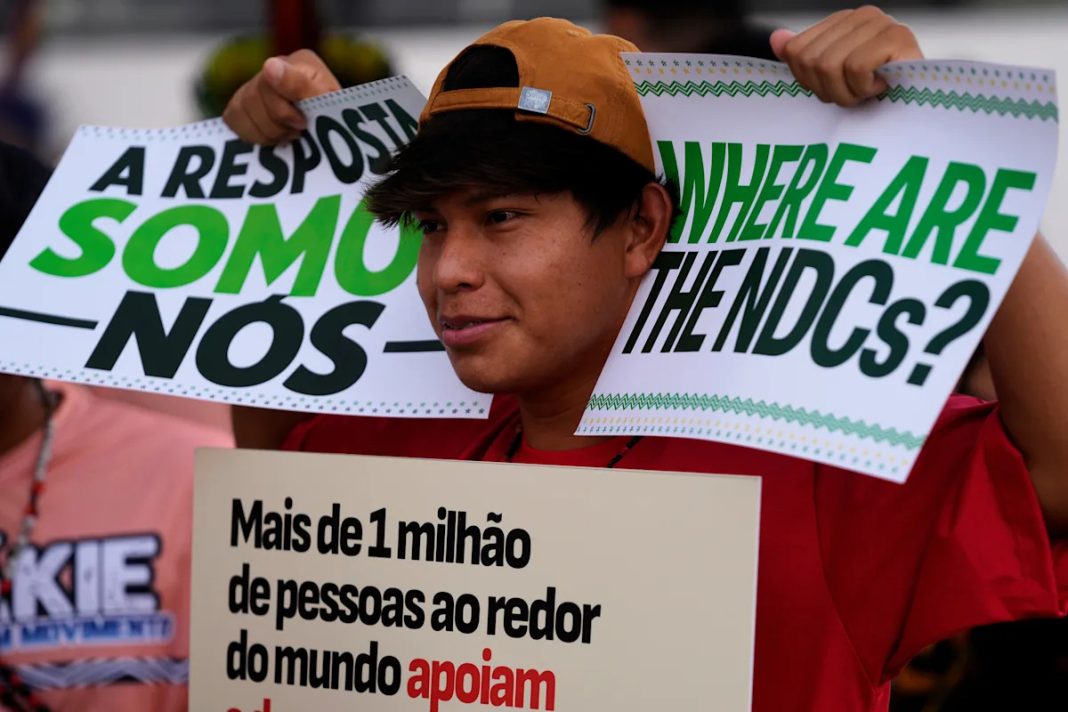Governments are falling far short of the promises they made to cut plant-warming pollution under the Paris climate agreement 10 years ago, the United Nations said in a report Tuesday.
Only a minority of countries have so far updated their commitments to tackling what the countries signing the pact called in 2015 “the urgent threat of climate change.” And the plans they submitted to date would cut global greenhouse gas pollution only modestly compared with levels they had pledged half a decade ago.
The lapse comes as President Donald Trump’s administration has pressured nations against measures to curb the use of fossil fuels, whose greenhouse gas emissions are increasing the dangers of a warming planet — and as rising energy prices have prompted European leaders to recommit to using energy sources such as natural gas.
Only 64 nations out of 195 parties to the Paris Agreement submitted updated domestic plans to reduce greenhouse gas emissions as required under the 2015 pact, the U.N. noted in its report of those commitments.
And one of the most aggressive pledges submitted by any nation is effectively dead: then-President Joe Biden’s pledge last year that the United States — the world’s No. 2 climate polluter behind China — will slash its greenhouse gas output by at least 61 percent from 2005 levels by 2035. Trump has disowned that goal and instead recommitted the country to producing and exporting more fossil fuels, while pressuring allies to buy more U.S. oil and natural gas.
Most G20 countries have not formally filed their plans with the U.N. Apart from the United States, only Australia, Canada, Brazil, Japan, Russia and the U.K. have done so.
And based on those that have been submitted, the U.N. report hinted at the disappointing targets for emissions cuts.
“It is not possible to draw wide-ranging global-level conclusions or inferences from this limited data set,” the report said.
Governments are expected to submit their plans at the COP30 U.N. climate talks next month in Brazil. Commitments were originally due in February, but the process was delayed after the reelection of Trump, who in his first administration had removed the United States from the Paris agreement and who did so again in January.
“This climate change, it’s the greatest con job ever perpetrated on the world, in my opinion,” Trump said during his U.N. General Assembly speech in September. “All of these predictions made by the United Nations and many others, often for bad reasons, were wrong. They were made by stupid people that have cost their countries fortunes and given those same countries no chance for success.”
The national climate policies that countries have submitted so far would push global greenhouse gas emissions 6 percent lower in 2035 than the levels than nations’ previous plans, submitted five years ago, had called for reaching by 2030, the U.N. assessment showed.
But even that incomplete accounting may be optimistic, since it includes Biden’s pledge that Trump has rejected.
Taken together, the policies that 64 nations floated would ensure their emissions peak before 2030 “with strong emissions reductions thereafter until 2035,” the report said. The plans projected those nations’ combined emissions would fall 17 percent compared with 2019 levels in 2035.
In totality, however, those marks mean countries are far behind the Paris goal of keeping temperatures “well below” 2 degrees Celsius of warming since the preindustrial era, a target that scientists have called essential for lessening global catastrophe. The Paris pacts’ stronger alternative goal of limiting temperature rise to 1.5 degrees Celsius is in even greater peril.
The United Nations’ Intergovernmental Panel on Climate Change found hitting the 2-degree mark requires global emissions to plummet 35 percent from 2019 levels by 2035. It would require a 60-percent drop to remain below 1.5 degrees, the U.N. report noted.
“Parties are bending their combined emission curve further downwards, but still not quickly enough,” the report said of the plans.
The forthcoming submissions will likely improve the bleak forecast the U.N. outlined in its report, which covered plans from nations comprising 30 percent of global greenhouse emissions. The analysis did not factor in China and Turkey, major polluters that have disclosed their overall targets but have not officially filed their plans. It also did not include the European Union, which is still negotiating its emissions strategy.
Many analysts view as underwhelming China’s overall goal of lowering emissions up to 10 percent from their peak by 2035, given the country has overtaken the United States as the world’s largest greenhouse gas emitter.
Meanwhile, the EU’s 27 countries have struggled to agree on new climate targets as they weigh economic the strain placed on their heavy industries. In lieu of a new climate target, the EU sent the U.N. a “statement of intent” saying it would reduce emissions by up to 72.5 percent below 1990 levels by 2035.
Simon Stiell, executive secretary of the U.N. Framework Convention on Climate Change, cautioned against drawing sweeping conclusions from the limited pool of updated plans.
An ongoing but incomplete U.N. analysis of plans that nations announced during the General Assembly in September but have not yet finalized could reflect a 10-percent global emissions decline by 2035, Stiell said in a statement.
“Countries are making progress, and laying out clear stepping stones towards net-zero emissions,” he said. “We also know that change is not linear and that some countries have a history of overdelivering.”

